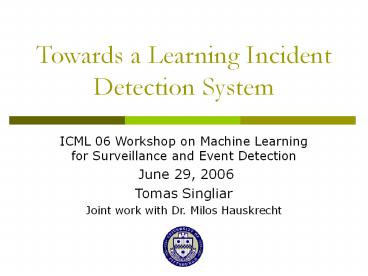Towards a Learning Incident Detection System - PowerPoint PPT Presentation
Title:
Towards a Learning Incident Detection System
Description:
Towards a Learning Incident Detection System. ICML 06 Workshop on Machine ... Joint work with Dr. Milos Hauskrecht. Outline. Replace traffic engineers with ML ... – PowerPoint PPT presentation
Number of Views:67
Avg rating:3.0/5.0
Title: Towards a Learning Incident Detection System
1
Towards a Learning Incident Detection System
- ICML 06 Workshop on Machine Learning for
Surveillance and Event Detection - June 29, 2006
- Tomas Singliar
- Joint work with Dr. Milos Hauskrecht
2
Outline
- Replace traffic engineers with ML algorithms for
incident detection - Traffic data collection and quality
- Why, who and for what purposes
- Incident detection algorithms
- Evaluation metrics
- Individual feature performance
- Sensor fusion with SVM
- Noisy data problems
- Attempts to model accident evolution with DBN
- Conclusions and future work
- Noisy data Poor onset tagging and bootstrap
3
Traffic data collection
- Sensor network
- Volumes
- Speeds
- Occupancy
- Data aggregated over 5 minutes
- Incidents
- police
- camera system
4
Incident Annotation
incident
no incident
incident
5
Incident annotation
- Incident labels not necessarily correct or timely
- Do not correct timing (opportunity for more ML ? )
6
Incident detection algorithms, intuition
- Incidents detected indirectly through caused
congestion - Baseline California 2 algorithm
- If OCC(up) OCC(down) gt T1, next step
- If OCC(up) OCC(down)/ OCC(up) gt T2, next step
- If OCC(up) OCC(down)/ OCC(down) gt T3,
possible accident - If previous condition persists for another time
step, sound alarm - Hand-calibrated T1-T3 very labor intensive
- Why so few ML applications?
- nontraditional data, anomaly detection rare
positives, common sense works well
Occupancy spikes
Occupancy falls
7
Evaluation metrics
- AMOC curve
- Time to detection (TTD) vs False positive rate
(FPR) - Dont know when exactly incident happened
- Maximal TTD (120min)
- AU interesting region of C
- Performance envelope
- Detection rate (DR) vs FPR
- Random gets over diagonal
- Report ROC as a check
- Sensitivity vs specificity
- Low false positive region
- 1 false alarm/day 150 sensors
8
Features
- Sensor measurements
- Temporal derivative
- Spatial differences
9
Features
- Simple measurements 3 per sensor, 6 total
- Occupancy lt threshold
10
Temporal features
- Capture abrupt changes
- Occupancy spike now minus previous time slice
11
Spatial differences
- Discontinuities in flow between sensor
positions - Difference in speeds downstream - upstream
12
Sensor fusion
- Information in all simple detectors
- How to combine their outputs?
- Linear combination SVM
13
Baseline California 2
- Hand-calibrated (brute force)
- Good low FAR performance, but poor detection rate
14
SVM
- Combines sensor measurements via a linear
combination
15
SVM
- Spatial relations
- Sensor measurements plus ratios and differences
from the neighboring sensor
16
SVM
- Temporal derivatives
- Sensor measurements plus differences and ratios
to previous step
17
Focus on low FAR
- California better persistency check
18
A dynamic Naïve Bayes network
- Problem Incidents are recorded later than they
occur - True state of highway is unobservable by sensors
- Picture of incidents evolves in time
- About 30 features 3 readings up/down stream,
differences, ratios to neighboring sensor,
previous time point
H
H
H
True hidden state
On
On
On
speed
O1
O1
O1
Occupancy(t-5)
I
I
I
Incident observed
19
A dynamic Naïve Bayes network
- Evolution of an accident
- Normal traffic steady state
- Accident happens, effects build up
- Constricted steady state
- Recovery
- Model has 4 hidden states
- Anchor hidden states to desired semantics clamp
p(IH) - Raise alarm if p(Hacc_stateO) gt threshold
- Learned hidden state transition matrix
0.9536 0.0332 0.0000 0.0133 0.0050
0.9577 0.0339 0.0034 0.0000 0.0882
0.9033 0.0084 0.0957 0.0000 0.0753
0.8290
20
DNB Performance
- Poor job at low FAR
- Fairly insensitive to threshold
21
Summary
- Challenges to ML in traffic incident detection
- Rare class data sparsity, unequal misclassif
cost - Incident annotations are noisy
- Machine learning methods competitive though
- SVM outperforms current practice
- No manual tuning, readapts to data after changes
- Lessons and surprises
- Richer feature sets do not help much
- Neither does removing diurnal trends (?)
- SVM has very stable performance
- Dynamic Naïve Bayes weak
22
Future work
- Discriminate incident and benign congestion
- Improve discriminative classification
- SVM with nonlinearities (?)
- Unequal misclassification cost models
- Improve dynamical models
- SVM handles time awkwardly Dynamic Bayes Nets
- Conditional random fields discriminative time
- Improve Data
- Bootstrap use even a strawman to label incident
start, learn from relabeled data (, iterate) - Supplemental materials available
- http//www.cs.pitt.edu/tomas/papers/icml06w/
- (AMOC curves that did not fit into the paper)
23
Thank you
- Questions?
- Suggestions?
24
SVM
- California 2 measurements
- Current and past occupancies
25
DNB Performance































